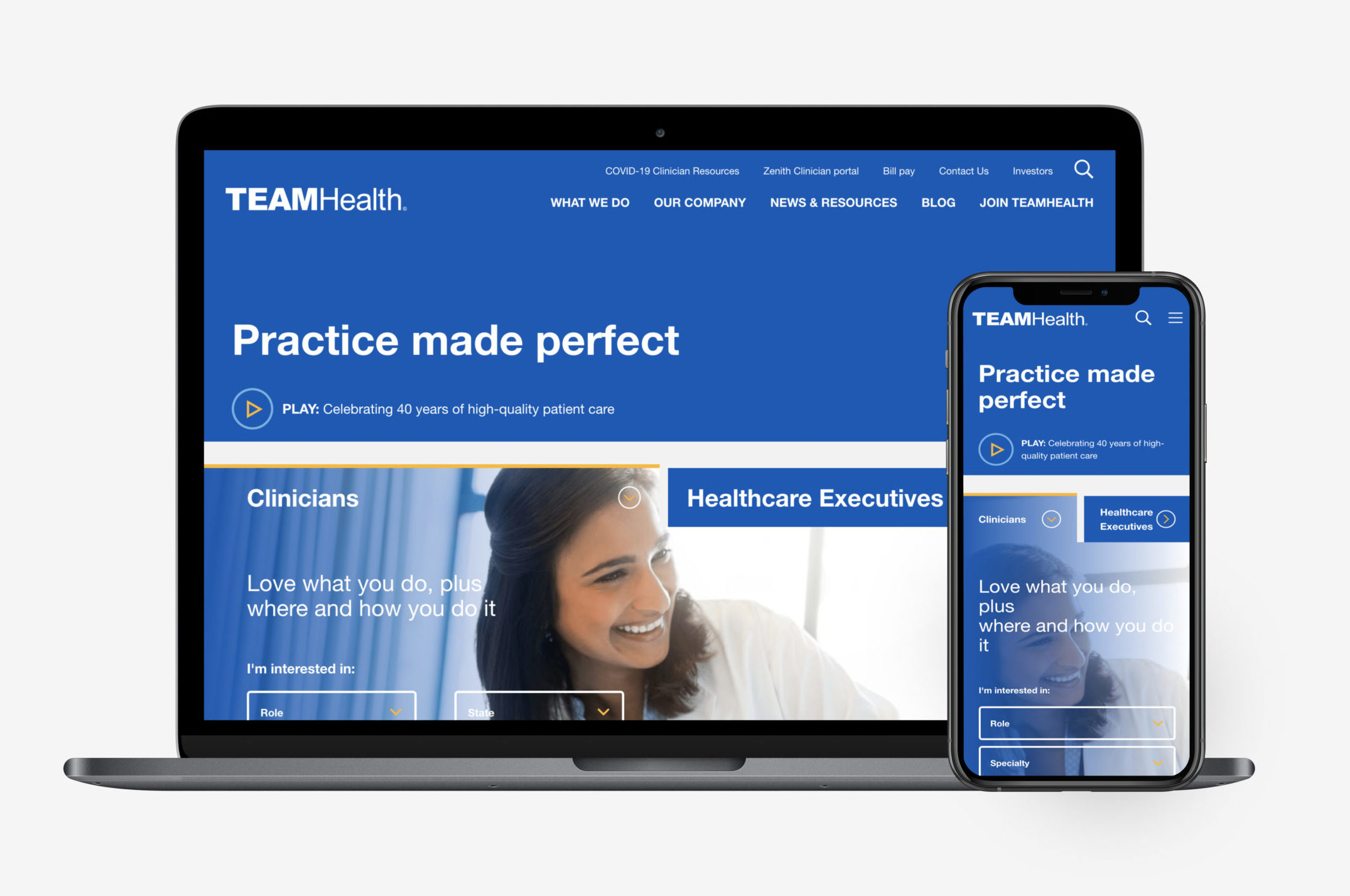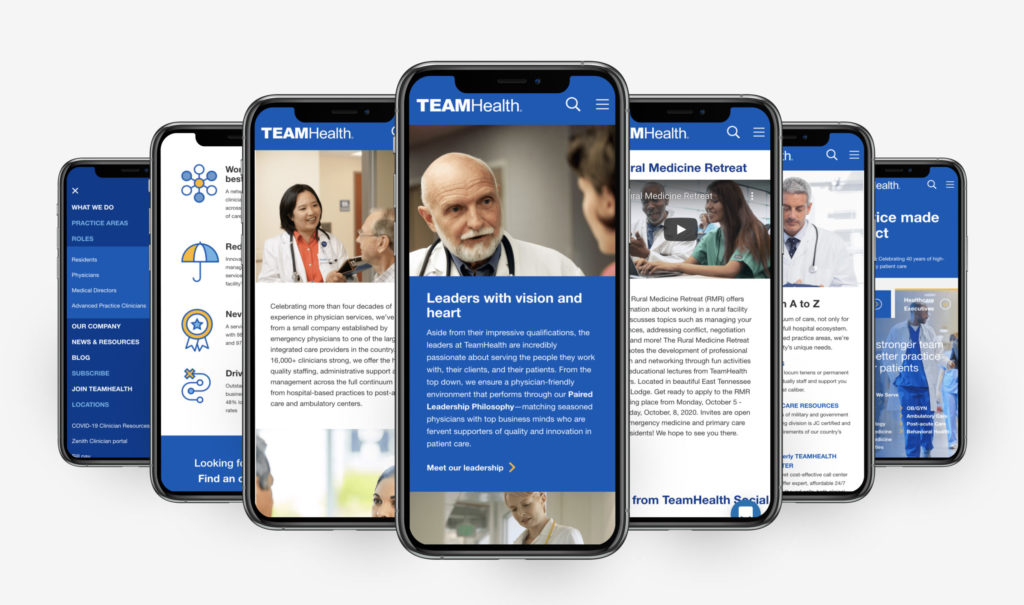Your website is the face of your healthcare business, so it needs to be operating at its best!
There’s nothing worse than going to an outdated healthcare website that provides a poor user experience. If your site has outdated information, isn’t visually appealing, or takes too long to load, you could be damaging your healthcare brand.
When it comes to your website, your patients will expect your site to be trustworthy, accessible, and a good source for educational information. Your website needs to contain components that provide this experience for your patients. Having a good website attracts patients to your company, gives them all the information they’re looking for and provides ways for them to continue their engagement with you.
Follow these best practices in your website design to have an inclusive, well-organized website.
Reasons to Redesign Your Healthcare Website
Staying current with digital trends on your site gives patients peace of mind that they are in good hands. Did you know 7% of daily Google searches are healthcare-related? That is about 1 billion searches per day! So many people are using the internet to search for a reputable resource, provider, or if their scratchy throat means that their foot will fall off. Your site needs to be an easy-to-use resource that can provide answers to your users.
With the healthcare field always evolving, it can be challenging to keep up with all the standards and expectations sometimes! Need an extra hand? The Pyxl team can help improve some of your website’s best practices with a redesign. Contact Pyxl.
If you’re still on the fence, here are 5 reasons to redesign your healthcare website today.
1. It’s not mobile-responsive. 60% of online searches come from a mobile device, so your website needs to function and provide a good user experience no matter the device your patients are using.
2. It does not have a user-friendly navigation. 67% of mobile users will leave a website if they are frustrated with the navigation. Think like a patient and make sure everything that’s important is easy to find.
3. It isn’t driving the results you need. No matter what your KPIs are, your website should be able to drive the results you’re looking for.
4. The content and/or design is outdated. An outdated website can hurt the credibility of your business so be sure to update every 3-4 years to keep up with your patients’ standards.
5. It is not integrated to your social media platforms or your blog. Your blog and social media are a great way to continue the conversation with your patients and go hand-in-hand with your integrated marketing strategy.
Now that we’ve talked about the importance of needing to keep your website updated, let’s dive into some helpful healthcare website guidelines.
Helpful Healthcare Website Guidelines
It can be incredibly challenging to keep up with industry website standards, which is why we’ve broken down all of the components your healthcare website needs to have to provide a good patient experience and promote trust. The following guidelines will help you keep your healthcare website up to date and secure as a trustworthy resource of information for your patients.
- Trends & features your healthcare website need to be and include:
- Examples of Impressive Healthcare Websites
Follow these guidelines to ensure you’re providing a great user experience for your patients.
It needs to be personable!
To truly connect with your audience, your website must be easy to digest and conversational. By making your healthcare website personable, you can build a deeper connection between you and your patient! Being personable is incredibly important, especially in healthcare as 80% of customers say they are more likely to do business with a company if it offers personalized healthcare experiences.
To create a personable healthcare website you should include:
- A staff directory to help put a face to your company
- Social media channels and blog posts to continue the conversation on a more personable note
- Imagery and healthcare video marketing that helps represent a human and emotional connection your patients can relate to
- Consistent branding tone and messaging that clearly illustrates your company’s value to your patients
- Personalized and tailored messaging through the use of conversational chatbots
- Telehealth options so you can connect with patients without in-person interaction
It needs to be mobile-responsive!
91% of adults have a mobile device that accesses the internet within arms reach. Many people may not even have a desktop anymore! We can’t stick to the old-fashioned way of accessibility on sites, your healthcare website needs to be mobile-responsive.
In order to be mobile-responsive, your website should adapt based on the size of the device being viewed. Healthcare sites must be easy to navigate regardless of screen size or style as it creates a good user experience and helps you maintain credibility with patients.
Why a mobile-responsive website is important:
- The mobile market is growing
- Increases patient referrals
- Increases credibility as a reliable healthcare provider
- Increases search visibility
- Cost-effective
- Improved customer experience
- Higher conversions
Mobile-responsive best practices:
- A design that is formatted well and includes enough white space to help make everything easy to read
- Easy navigation that doesn’t take up the entire mobile screen
- Adaptive design
- Quick to read and easy to follow paragraphs
- Important content is kept above the fold
Not only is it more pleasing to navigate, having a mobile-responsive website increases search visibility on search engines, and increases patient referrals. Win-win-win!

Looking for more information on mobile responsive website design? Download our guide:
It needs to be compliant!
The top priority for healthcare websites is remaining both ADA and HIPAA compliant. To produce the best care available, your site needs to be accessible and easy to ingest for all patients.
ADA Compliance
According to the Americans with Disabilities Act Standards for Accessible Design, all websites and technologies must be accessible to people with disabilities, such as those who are blind, deaf, or in-mobile.
As of 2018, websites for any place of public accommodation are required to be ADA compliant, or your business will be fined! So not only is it a best practice to accommodate all website users, it’s all legally required.
How to have an ADA compliant website:
- Optimal text size
- Color accessibility
- Closed captions on video marketing
- Alt tags for images
- Navigable by keyword for moto impairment
It is much more efficient to set up an ADA compliant website from the start than to make changes to the existing content. Skilled website developers know exactly what steps have to be taken to avoid fines. Contact Pyxl if you need help!
Not sure if your website is following ADA compliance standards? Download our ADA Compliance Checklist to ensure you’re following ADA compliance requirements.
HIPAA Compliance
Under HIPAA regulations, the legal use and disclosure of protected health information must comply with specific regulations. It is important not only to follow these regulations in your daily care, but online as well. HIPAA compliance on your website is essential to ensure the security of patient information. Because the changing laws and regulations can make it difficult to keep up with healthcare compliance standards, we’ve listed a few HIPAA compliance website best practices.
What your healthcare website needs in order to be HIPAA compliant:
- Privacy agreement and authorization
- Storage encryption
- Business associate agreements
- Protect private health information
Remember that your healthcare site is a resource, and should never give away vital patient information. As more and more healthcare resources are internet-based, there is a stronger need for patient security. Make sure to put steps in place to remain HIPAA compliant on your healthcare website.
It needs to be credible!
Your healthcare site is a one-stop shop for any questions your patients may have. Whether you are providing healthcare services or equipment, end users are putting their trust in you to provide them with answers.
To be a credible website and resource for patients, your site should showcase:
- Case studies from real patients that share details of your expertise
- Before and after stories to show real results
- Online reviews and testimonials from previous patients
Let’s take a look at naviHealth, a healthcare website we redesigned that showcases testimonials on their homepage. For each dedicated audience, there are testimonials and images that facilitate trust.
Here are some other best practices of how to showcase your credibility within your website content:
- Content should be educational as your website is a resource for patients, not a sales tactic.
- Incorporate key metrics and data to prove your expertise and back up any claims you make within your content.
- Social proof is where people tend to adopt the opinions or actions of people they trust. You can build social proof on your website by incorporating blogs, awards and social media
It needs to have high-quality content!
Being a thought leader in healthcare means staying on top of trends, providing innovative care and staying ahead of the competition. This should reflect on your website as well.
Incorporate content on your website that showcases your team is:
- Trustworthy
- Has a desire to learn and grow
- Achieves long term results
A variety of ways to showcase thought leadership on your website includes:
- Answering common questions on the home page
- Writing relevant and timely educational blogs and resources
- Social media access on homepage, footers and blog posts
Staying open and honest with high-quality content on social media channels and blog posts shows your patients you are prepared to answer their questions before they even think of them. Who doesn’t want service from an industry leader?
It needs to be accessible!
58% of the world’s population uses the internet daily, and 15% of the world’s population experience some form of disability! Your healthcare website needs to be accessible to all users so your current and future patients can have a great user experience on your website and easily find the information they’re looking for. It’s important that everyone has an opportunity to easily connect with your healthcare website and services.
Best practices for an accessible website:
- Assistive technology
- Accessible formats for all content
- Keyboard friendly
- Contrasted colors
- Resizable text
- Easy to find FAQ
- Easy navigation
It needs to use Artificial Intelligence (AI)!
Automation tools and technologies are used to automate time-consuming and redundant tasks so you can streamline processes and focus on your patients. AI can be used in numerous ways in healthcare marketing and website development to create a well-rounded patient experience!
Here are a few ways AI can help improve your healthcare website:
- Improve the patient experience by providing answers and solutions while they’re actively engaged on your website
- Save time for staff members by automating time consuming tasks
- Utilize predictive analytics for patient’s needs
Ways to utilize AI on your healthcare website:
- Automated chatbots provide 24/7 support while the user is most engaged
- Online scheduling creates 24/7 convenience for your patients
- Healthcare cost estimators ease financial concerns amd promote transparency and trust with your practice.
- Telehealth options allow more opportunities to connect with your patients online
- Learning algorithms that predict customer patterns
Cleveland Clinic is a great example of a healthcare website that has a chatbot available on the home page to help streamline the website experience for its patients. It incorporates buttons for appointments, finding a doctor, finding locations, and COVID-19, which cater to the common needs of their website users.
Digital Tip: Utilize email marketing automation tools outside of your website to create a more personalized patient experience, even outside of your healthcare facility doors.
It needs to have a positive user experience!
Your healthcare site needs to bring real value to your patients! No one wants to dig around the internet for hours trying to answer healthcare questions. Patients prefer clear, concise information that includes visual elements that answer any questions they may have.
By making your site content easy to grasp, your patients trust you have their best interest at heart.
Best practices for a positive user experience:
- No industry jargon
- Use relatable imagery throughout your website pages
- Incorporate videos to put a face to the business and further explain a topic
- Write your content with bullets and lists for quick and easy reading
- Design with white space in mind to help with the flow and UX/UI
Examples of Impressive Healthcare Websites
We hope the information provided above is able to guide you in the right direction or creating an excellent healthcare website, but let’s take a look at some real-life healthcare website examples that we think follow some best practices.
TEAMHealth
Use these current healthcare websites as examples to guide you!
Pyxl had the honor of working with TeamHealth on their website rebranding. Through the use of diverse imagery and straightforward messaging on a mobile responsive website, their team now has a user-friendly site tailored to patients. Read more about how Pyxl helped their website.

Northwestern Medicine
Check out Northwestern Medicine’s website. Their site is simple but bold with its color choices. The navigation is easy to understand, and the CTA’s are in a clear location.
Mercy Health
Check out Mercy Health’s website. They have their online bill pay and patient portal easy to locate on the home page. The bold imagery is welcoming throughout their entire website.
Partner with Pyxl
There are a lot of factors that play into a trustworthy healthcare website. Whether you are starting from scratch or looking for a redesign, it is important to continually audit your site to stay on top of current industry trends. In the modern digital age, your healthcare site is the face of your business. Your patients deserve an accessible, inclusive, appealing site that answers any questions they may have.
We understand how hard it is to stay up to date with your website. Your patients are the priority, so leave the healthcare website redesign to our digital experts at Pyxl. Contact us to get started! We can help you at any step of the process. Our team has worked on several healthcare sites to create a simple yet robust patient experience. Check out naviHealth, TeamHealth, and egnite to see our work in the healthcare industry! Let us help you be an industry leader in healthcare today!
Updated: Apr 13, 2022
 Kati Terzinski
Kati Terzinski



 Erin Murray
Erin Murray